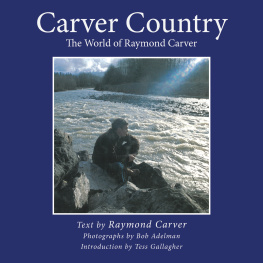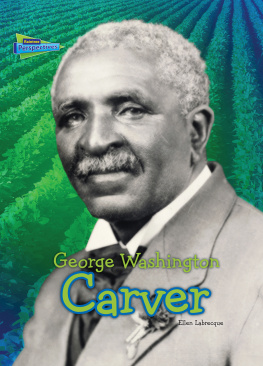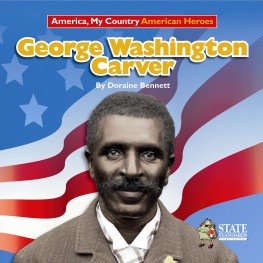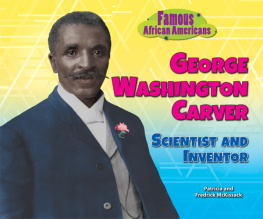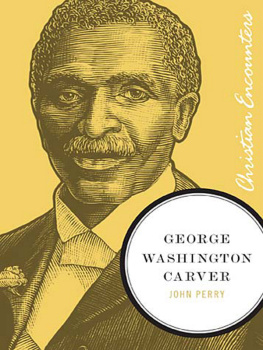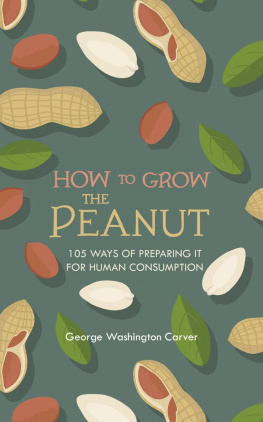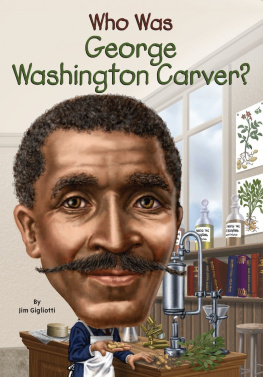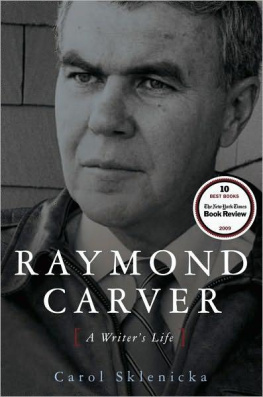GEORGE WASHINGTON CARVER
Southern Biography Series
ANDREW BURSTEIN, SERIES EDITOR
GEORGE
WASHINGTON
CARVER
A LIFE
CHRISTINA VELLA
Louisiana State University Press | Baton Rouge
Published by Louisiana State University Press
lsupress.org
Copyright 2015 by Christina Vella
All rights reserved. Except in the case of brief quotations used in articles or reviews, no part of this publication may be reproduced or transmitted in any format or by any means without written permission of Louisiana State University Press.
Louisiana Paperback Edition, 2022
Designer: Michelle A. Neustrom
Typeface: Whitman
Cover photograph of Carver courtesy of
the Library of Congress.
LIBRARY OF CONGRESS CATALOGING-IN-PUBLICATION DATA
Vella, Christina.
George Washington Carver : a life / Christina Vella.
pages cm (Southern biography series)
Includes bibliographical references and index.
ISBN 978-0-8071-6074-9 (cloth : alkaline paper) ISBN 978-0-8071-6075-6 (PDF) ISBN 978-0-8071-6076-3 (ePub) ISBN 978-0-8071-7719-8 (paperback) 1. Carver, George Washington, 1864?1943. 2. African American agriculturists Biography. 3. AgriculturistsUnited StatesBiography. 4. African American scientistsBiography. 5. Tuskegee InstituteHistory. 6. AgricultureResearch Southern StatesHistory. 7. PeanutsUnited StatesHistory. I. Title.
S417.C3V45 2015
630.92dc23
[B]
2015006259
To the memory of my dear mother, Nickie Vella
that little firecracker.
CONTENTS
ACKNOWLEDGMENTS
T his book would not have been possible without the help of a small army of archivists and librarians. Foremost among the individuals who led me to materials on Carver is Curtis Gregory of the George Washington Carver National Monument in Diamond, Missouri, who pulled out all sorts of records, cheerfully allowing me to take up his time for two weeks. I am especially grateful to Nanette Hardison in the Joyner Library, East Carolina University, who went to some trouble to make the Lucy Cherry Crisp manuscript available to me. Dr. Ida E. Jones of Howard University Library provided several important documents. Hayden Battle, Patricia Windham, and Arely Bel Martinez of Tulane Universitys interlibrary loan department were, as always, my lifeline to distant collections.
The staffs of the following university libraries were most gracious in allowing me to consult their microfilm, manuscript, and newspaper holdings. I want to thank Harvard, Princeton, Yale, Columbia, Michigan, Tulane, Loyola, Virginia Tech, and Michigan State Universities, Tuskegee Institute, and the University of New Orleans. I received valuable research help from the U.S. Department of Agriculture, the National Archives, the Library of Congress, and the Franklin Delano Roosevelt Library, all in Washington, D.C.; the Franklin Delano Roosevelt Presidential Library, Hyde Park, New York; and the Southern Regional Research Center in New Orleans. The staff of Special Collections at Iowa State University Library deserves its own line in this compendium for making available its entire George Washington Carver Collection, including its copies of materials in Tuskegee.
Among the civilians who provided assistance of various kinds, I am deeply indebted to Samuel Ferraro for his intelligent research into the Austin Curtis Papers at the University of Michigan. Dr. Wade Shields provided patient computer advice when it was needed (and it was always needed), Nathan Wexler, M.D., offered expertise on medical issues concerning Carver, and Dr. William C. Davis tracked down information about Jim Hardwick. Harriet Swift, my longtime friend, kindly provided the index.
I feel a special attachment to LSU Press for the staffs courtesy and kindness, both past and present, and for the presss high standards. My sincere thanks to MaryKatherine Callaway, Rand Dotson, Andrew Burstein, Neal Novak, and the designers, publicists, and other contributors to the publication of Carvers biography.
Professor Ron Chapman was kind enough to read the manuscript and respond enthusiastically. Finally, I want to thank my little girls, Professors Christie Riehl and Robin Vella Riehl, for reviewing the final draft, chuckling appropriately here and there, and making many good suggestions.
GEORGE WASHINGTON CARVER
1

CARVERS GEORGE
T hough it was the most shattering event of his life, George Carver had no memory of the kidnapping. It happened when he was only a few weeks old, during the Civil War. He could not even remember clearly what he had been told about it later on. He and his mother were kidnapped by raiders who snatched them from their cabin in southwest Missouri and took them to Arkansas, seventy miles south. He was somehow separated from his mother, who mysteriously disappeared. Their master, Moses Carver, sent a neighbor after them, a man named John Bentley who belonged to the local militia of the Union Army. Carver promised Bentley a racehorse worth $300, perhaps some money, and perhaps forty acres of farmland if he could recover the slaves. Bentley found George being watched, if not quite looked after, by some women he described as squaws. He wrapped his coat around the infant, tied him to his saddle, and brought him back, traveling at night and hiding during the day from both the Confederate and Union forces that were prowling the vicinity. Mary, Georges mother, was never seen again. Even after his name was known all over the country, George Washington Carver could never find out whether his mother was dead or alive or what had happened to her during that frightful abduction. Someone said she had been sold in Arkansas. Another thought he had seen her going off with Union troops. Freed slaves were wont to follow the army that had emancipated them in those first bewildering months of freedom, but it is unlikely that Mary voluntarily left the area and abandoned both her childrenGeorge, the baby, and his brother Jim, who was still in Missouri. The exact time of the kidnapping, Georges precise age, the terms of the bargain between Moses Carver and Bentleyall these are uncertain. Even the year of George Carvers birth is undetermined.
On the other hand, enough information has been gathered about Moses Carver to give us a fair idea of how little George lived after he was returned to his ownerwe know more about his childhood, in fact, than about many others who grew up in the aftermath of the Civil War.
M oses Carver had come to the settlement then known as Diamond Grove in 1837, some twenty-five years before the kidnapping. That corner of Missouri was the West in the minds of the people who migrated therepromising and foreboding. The hills were forested just as in the East, but these hills were infested with bandits. In winter, the wind that battered the Ozark peaks entered the valleys as steady, panting cold. Summer was suffocating and still, except for swarming insects. The land itself, knowing no boundaries in those days except water and mountain, was Arkansas, or Missouri, or Kansas, or Oklahoma Indian Territory, everywhere riddled with streams and thick with woods. The prairies were not the vast, undulating grasslands of the farther West but ragged, green handkerchiefs set down between moist draperies of oak and elm. Four Carver brothers, Moses, George, Solomon and Richard, arrived within a few months of each other, bringing their families. Moses Carvers patents from the government assured him of four adjoining tracts of public land and several decades of backbreaking labor.
Moses Carver was twenty-five when he began clearing his property, the hardest part of confirming his claim. Every acre of field was wrested from thicket, from tough briars that had to be burned, from trees that clung to life with ancient, stubborn roots. The tangle of brush had no paths except those made by the hooves of his animals and the feet of his family. Working alone, he pried stones out of the earth or buried them under soil that he hauled up from the banks of the stream that vacillated through his land. On the edges of the fields, undergrowth reached out to reclaim the strips as soon as he had cleared them. Yet within a few years, the woods were pushed back. The farm was laid out with crops and fruit orchards, fenced by close-set rows of black walnut trees; the barns and coops were up and filled with livestock; and Carver, the enthusiast of toil, purchased more weeds and woods to clear. By 1853, his farm spread over 240 acres, with apple and cherry orchards, hundreds of Dutch elm and cultivars, sixty-five acres of oats, potatoes, Indian corn, and more. It is no surprise that the youngster raised by Moses Carver thought unremitting overwork was a way of life.
Next page

